Link Characteristics Comparison of Lambertian & Non-Lambertian MIMO-Based 6G Vehicular Visible Light Communications
Abstract
1. Introduction
2. Vehicular MIMO Visible Light Communications Based on Distinct Light Beam Configurations
2.1. Vehicular MIMO Visible Light Communications Based on Baseline Lambertian Light Beam Configuration
2.2. Vehicular MIMO Visible Light Communications Based on Z-Power Non-Lambertian Light Beam Configuration
2.3. Vehicular MIMO Visible Light Communications Based on Asymmetric NSPW Non-Lambertian Light Beam Configuration
3. Numerical Evaluation
3.1. Effect of Longitudinal and Lateral Displacements
3.2. Effect of Emitted Power
3.3. Effect of Receiver Spacing
4. Conclusions
Author Contributions
Funding
Data Availability Statement
Conflicts of Interest
References
- Refas, S. Performance Analysis of Bidirectional Multi-Hop Vehicle-to-Vehicle Visible Light Communication. IEEE Access 2023, 11, 129436–129448. [Google Scholar] [CrossRef]
- Yahia, S.; Meraihi, Y.; Ramdane-Cherif, A.; Ho, T.D.; Eldeeb, H.B. Enhancement of Vehicular Visible Light Communication Using Spherical Detector and Custom Lens Combinations. IEEE Access 2023, 11, 21600–21611. [Google Scholar] [CrossRef]
- Meghraoui, A. Is Visible Light Communications Suitable for Using in Lane-Changing Maneuvers. In Proceedings of the 2023 International Conference on Advanced Technologies for Communications (ATC), Da Nang, Vietnam, 19–20 October 2023; IEEE: New York, NY, USA, 2023. [Google Scholar]
- Ullah, A.; Choi, W.; Coleri, S. Path Loss Estimation and Jamming Detection in Hybrid RF-VLC Vehicular Networks: A Machine-Learning Framework. IEEE Sens. J. 2023, 23, 31325–31336. [Google Scholar] [CrossRef]
- Haas, H. Introduction to indoor networking concepts and challenges in LiFi. J. Opt. Commun. Netw. 2020, 12, A190–A203. [Google Scholar] [CrossRef]
- Shaaban, R.; Faruque, S. Cyber security vulnerabilities for outdoor vehicular visible light communication in secure platoon network: Review, power distribution, and signal to noise ratio analysis. Phys. Commun. 2020, 40, 101094. [Google Scholar] [CrossRef]
- Zhang, Y.; Wang, Y.; Deng, Y.; Du, A.; Liu, J. Design of a Free Space Optical Communication System for an Unmanned Aerial Vehicle Command and Control Link. Photonics 2021, 8, 163. [Google Scholar] [CrossRef]
- Chowdhury, M.Z.; Hasan, M.K.; Shahjalal, M.; Hossan, M.T.; Jang, Y.M. Optical wireless hybrid networks: Trends, opportunities, challenges, and research directions. IEEE Commun. Surv. Tutor. 2020, 22, 930–966. [Google Scholar] [CrossRef]
- Saikrishnan, S.; Singh, P.; Singh, A.; Srivastava, A. Hybrid RF-VLC Technology for V2X in Platooning Applications Under Different Weather Conditions. In Proceedings of the 2024 IEEE Wireless Communications and Networking Conference (WCNC), Dubai, United Arab Emirates, 4–7 September 2024; IEEE: New York, NY, USA, 2024. [Google Scholar]
- Deng, P.; Kavehrad, M. Adaptive real-time software defined MIMO visible light communications using spatial multiplexing and spatial diversity. In Proceedings of the 2016 IEEE International Conference on Wireless for Space and Extreme Environments (WiSEE), Aachen, Germany, 23–25 June 2016; IEEE: New York, NY, USA, 2016. [Google Scholar]
- Mmbaga, P.F.; Thompson, J.; Haas, H. Performance Analysis of Indoor Diffuse VLC MIMO Channels Using Angular Diversity Detectors. J. Light. Technol. 2016, 34, 1254–1266. [Google Scholar] [CrossRef]
- Sejan, M.A.S.; Rahman, M.H.; Aziz, M.A.; Kim, D.-S.; You, Y.-H.; Song, H.-K. A Comprehensive Survey on MIMO Visible Light Communication: Current Research, Machine Learning and Future Trends. Sensors 2023, 23, 739. [Google Scholar] [CrossRef] [PubMed]
- Liu, W.; He, X. Performance Analysis of MIMO Visible Light Based V2V Communications. In Proceedings of the 2019 IEEE 89th Vehicular Technology Conference (VTC2019-Spring) , Kuala Lumpur, Malaysia, 28 April–1 May 2019; IEEE: New York, NY, USA, 2019. [Google Scholar]
- Li, G.; Niu, W.; Ha, Y.; Hu, F.; Wang, J.; Yu, X.; Chi, N. Position-Dependent MIMO Demultiplexing Strategy for High-Speed Visible Light Communication in Internet of Vehicles. IEEE Internet Things J. 2022, 9, 10833–10850. [Google Scholar] [CrossRef]
- Farahneh, H.; Hussain, F.; Hussain, R.; Fernando, X. A Novel Optimal Precoder and Equalizer in 2 × 2 MIMO VLC Systems for Vehicular Application. In Proceedings of the 2018 IEEE Globecom Workshops (GC Wkshps), Abu Dhabi, United Arab Emirates, 9–13 December 2018; IEEE: New York, NY, USA, 2018. [Google Scholar]
- Okasha, N.M.; Zekry, A.H.A.; Newagy, F.A. Developing hybrid car-to-car communication system based on MIMO visible light and radio frequency. J. Wirel. Com Netw. 2022, 114, 1–19. [Google Scholar] [CrossRef]
- Mansour, I.M.; Farahneh, H. Comparison of Various Detection Algorithms in a 2 × 2 MIMO VLC Systems for Vehicular Application. In Proceedings of the 2023 2nd International Engineering Conference on Electrical, Energy, and Artificial Intelligence (EICEEAI), Zarqa, Jordan, 27–28 December 2023; IEEE: New York, NY, USA, 2023. [Google Scholar]
- Jia, J.; Zou, P.; Hu, F.; Zhao, Y.; Chi, N. Flexible Data Rate V2X Communication System beyond 1.84 Gb/s Based on MIMO VLC and Radar Integration. Appl. Sci. 2020, 10, 6636. [Google Scholar] [CrossRef]
- Azizi, M.; Zeinali, F.; Mili, M.R.; Shokrollahi, S. Efficient AoI-Aware Resource Management in VLC-V2X Networks via Multi-Agent RL Mechanism. IEEE Trans. Veh. Technol. 2024, 73, 14009–14014. [Google Scholar] [CrossRef]
- Ding, J.; I, C.-L.; Wang, J.; Song, J. Coverage Performance of Non-Lambertian Underwater Wireless Optical Communications for 6G Internet of Things. Inventions 2024, 9, 49. [Google Scholar] [CrossRef]
- Kumar, A.; Ghorai, S.K. Effect of LED Radiation Pattern on BER Performance in Indoor Multipath MIMO-VLC System. Wirel. Pers. Commun. 2020, 113, 2009–2026. [Google Scholar] [CrossRef]
- Moreno, I.; Sun, C.-C. Modeling the radiation pattern of LEDs. Opt. Exp. 2008, 16, 1808–1819. [Google Scholar] [CrossRef] [PubMed]
- Nakagawa, M. Fundamental analysis for visible-light communication system using LED lights. IEEE Trans. Consum. Electron. 2004, 50, 100–107. [Google Scholar]
- Ding, J.; Chih-Lin, I.; Xu, Z. Indoor optical wireless channel characteristics with distinct source radiation patterns. IEEE Photonics J. 2016, 8, 1–15. [Google Scholar] [CrossRef]
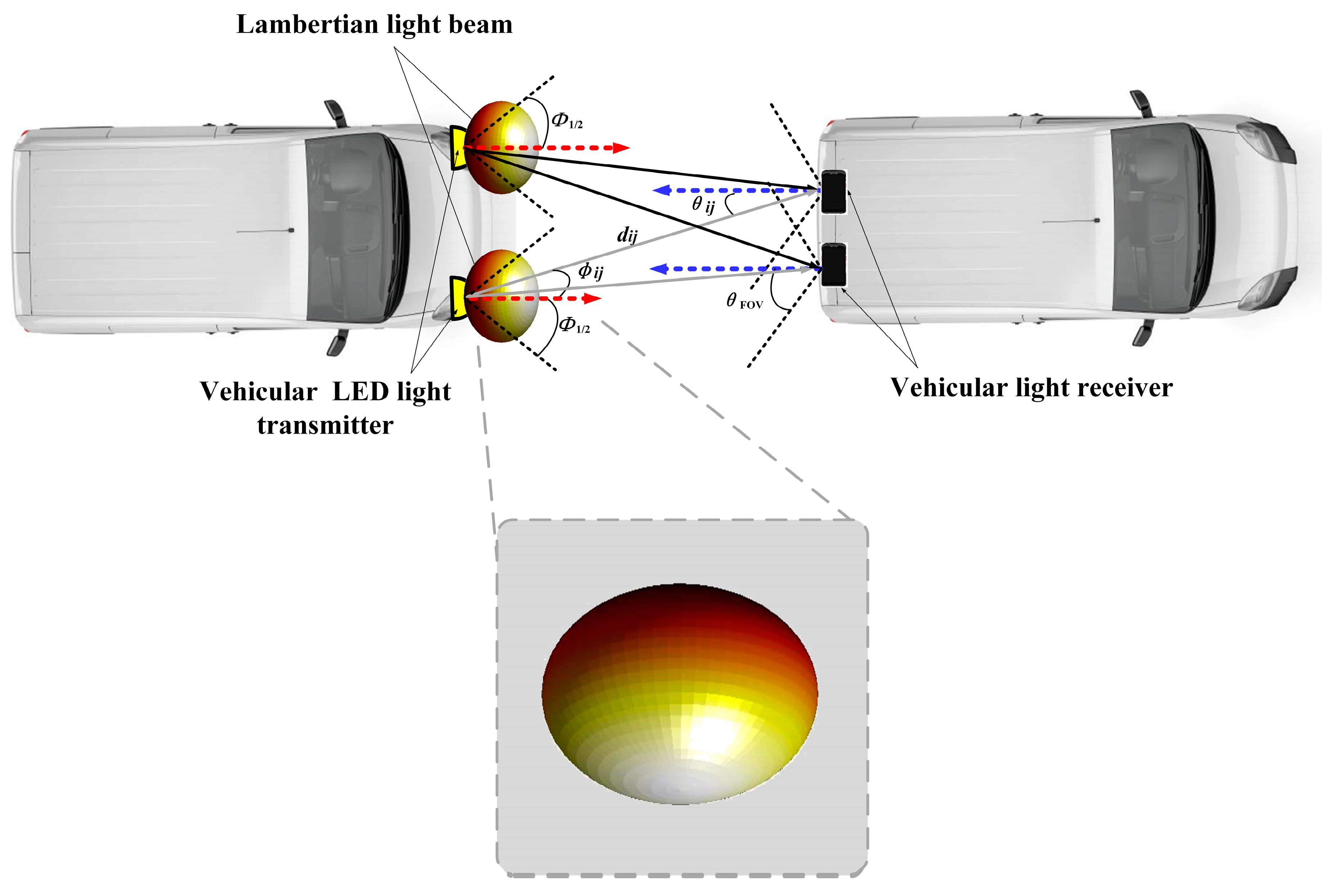
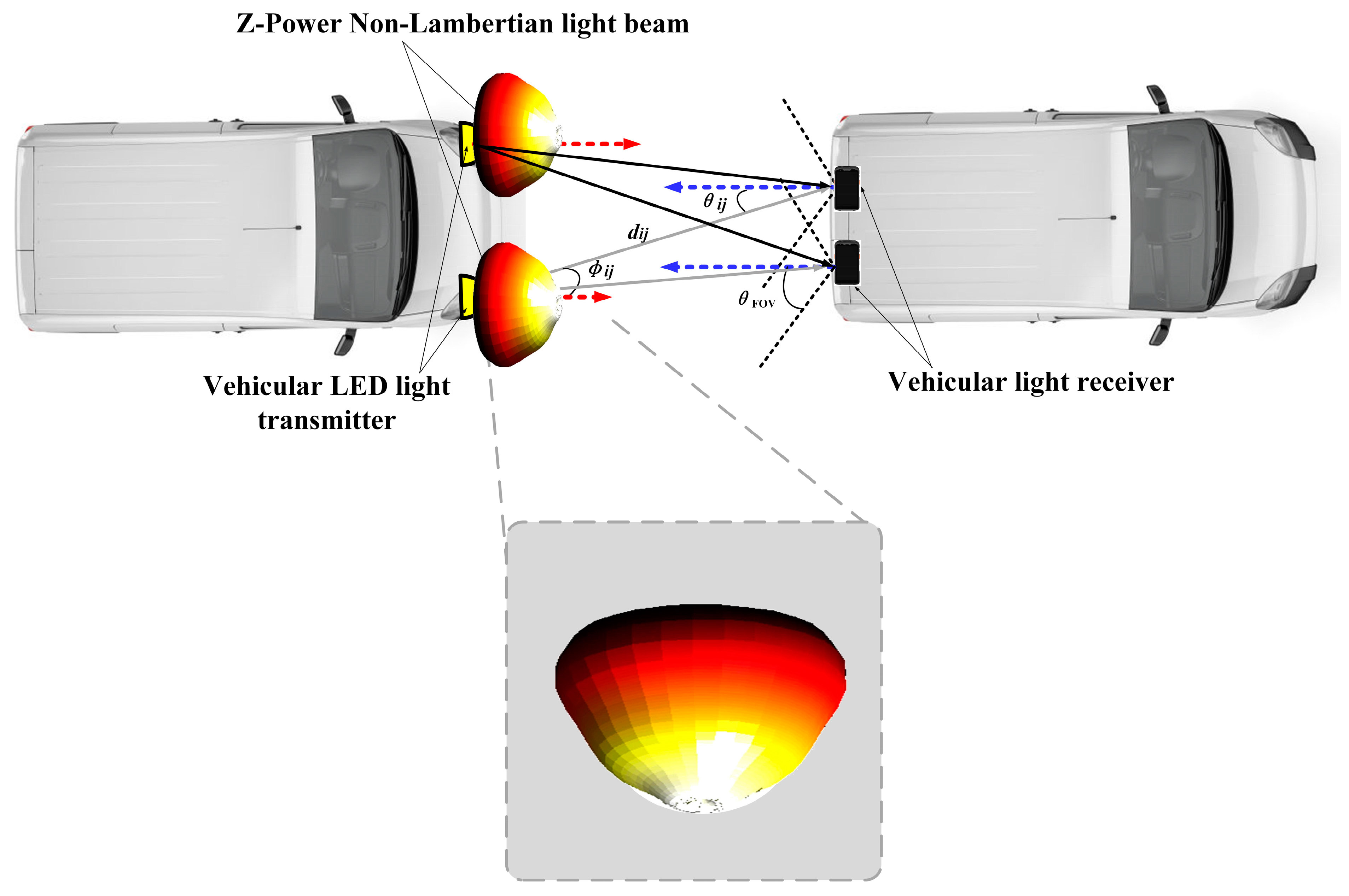
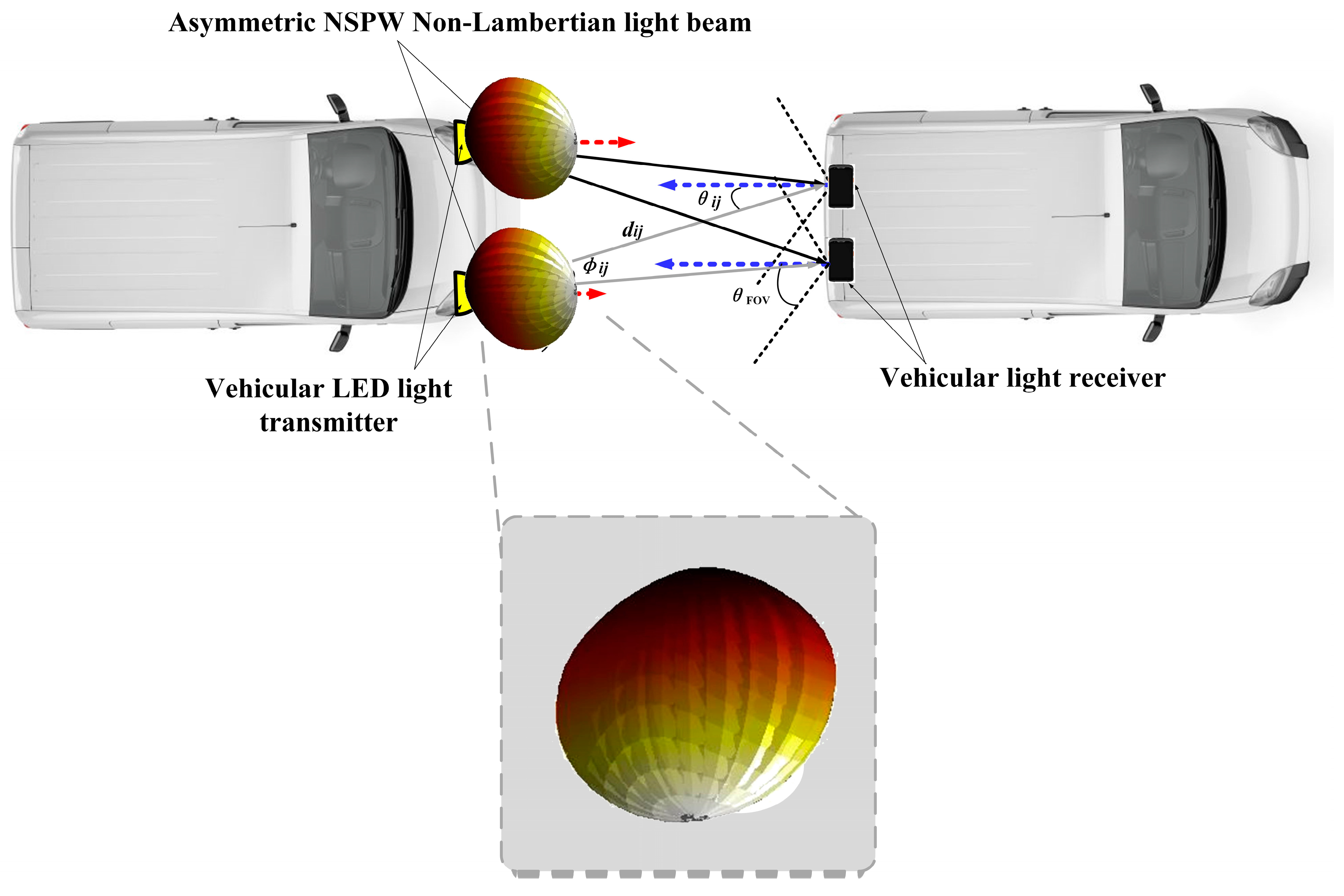
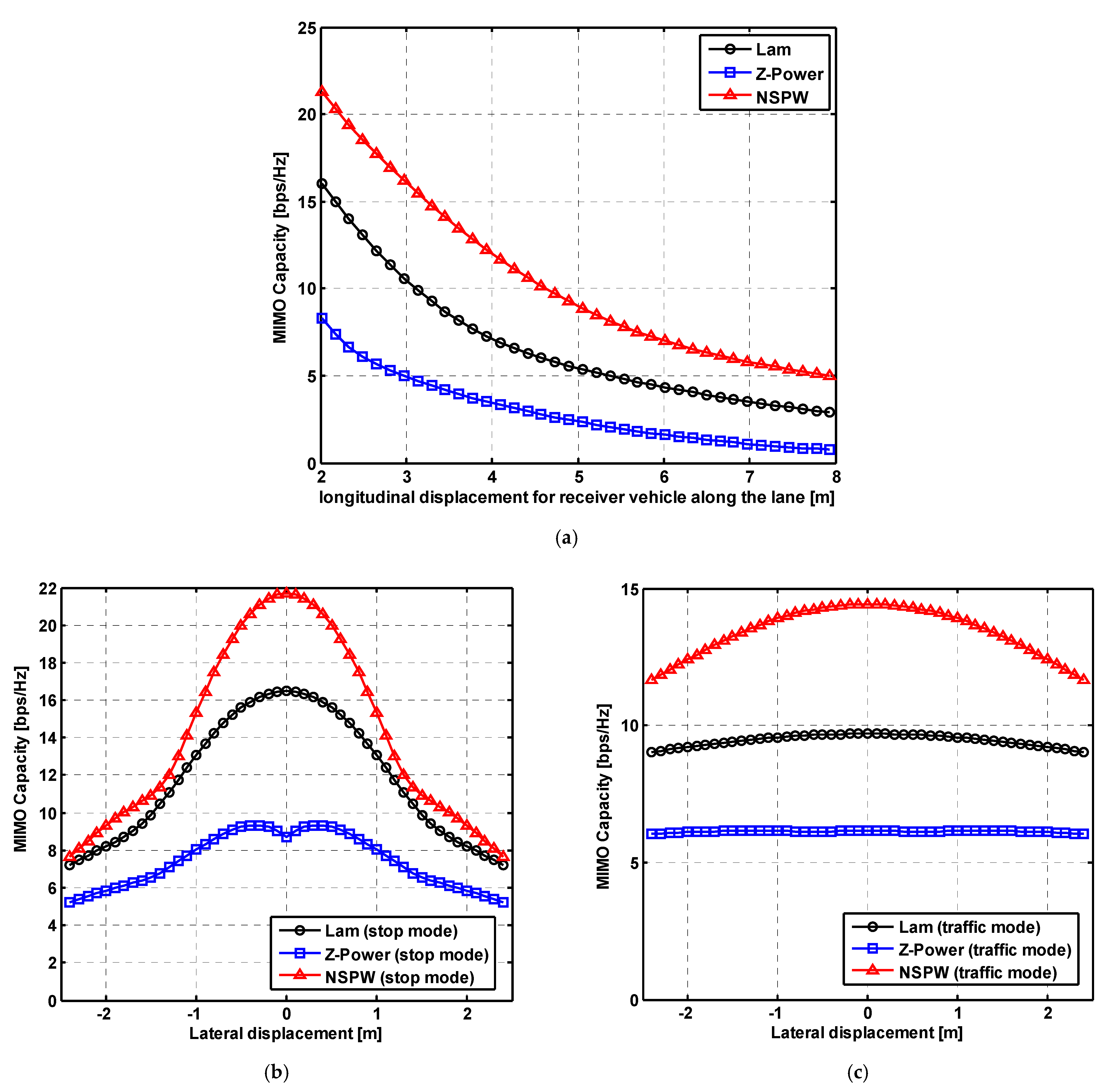
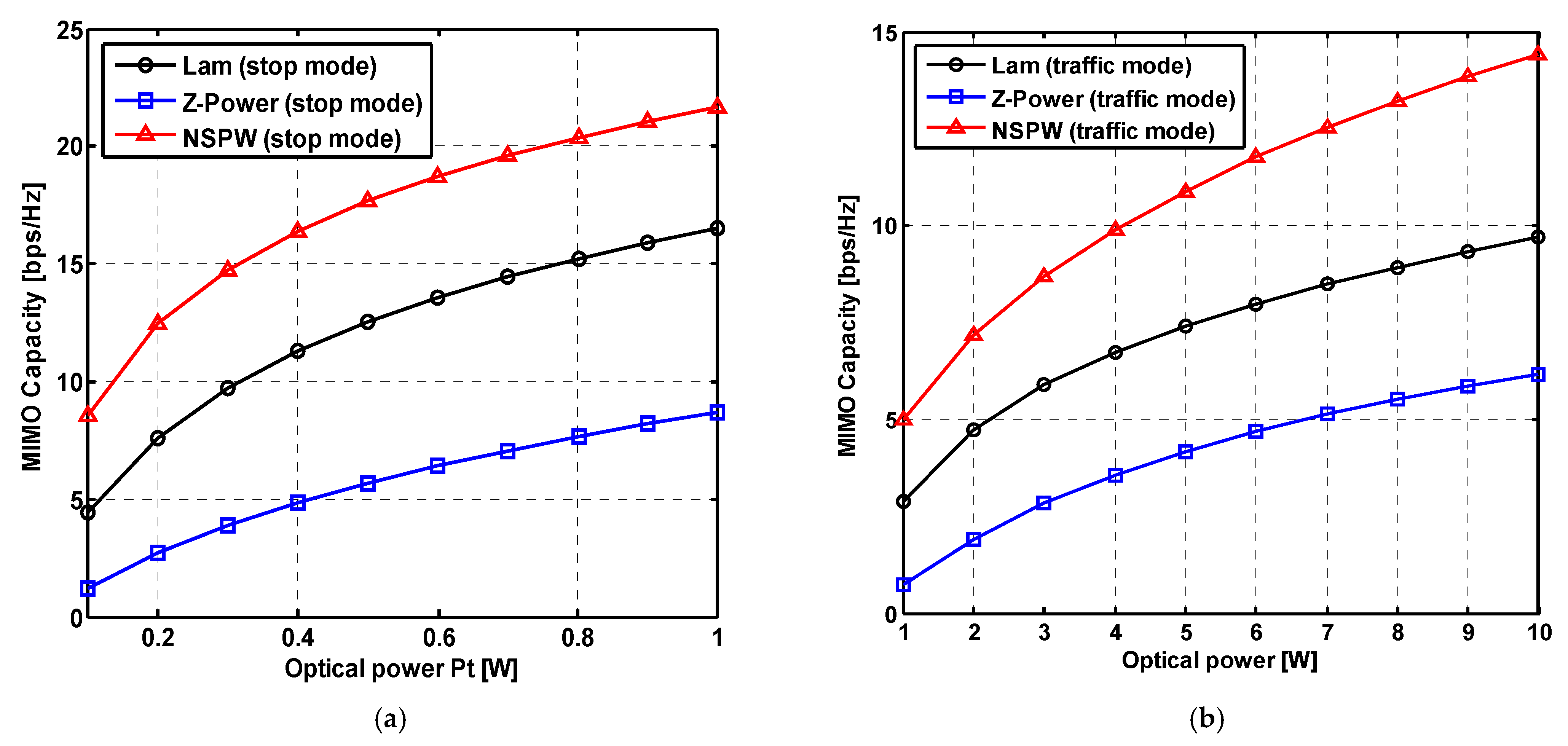
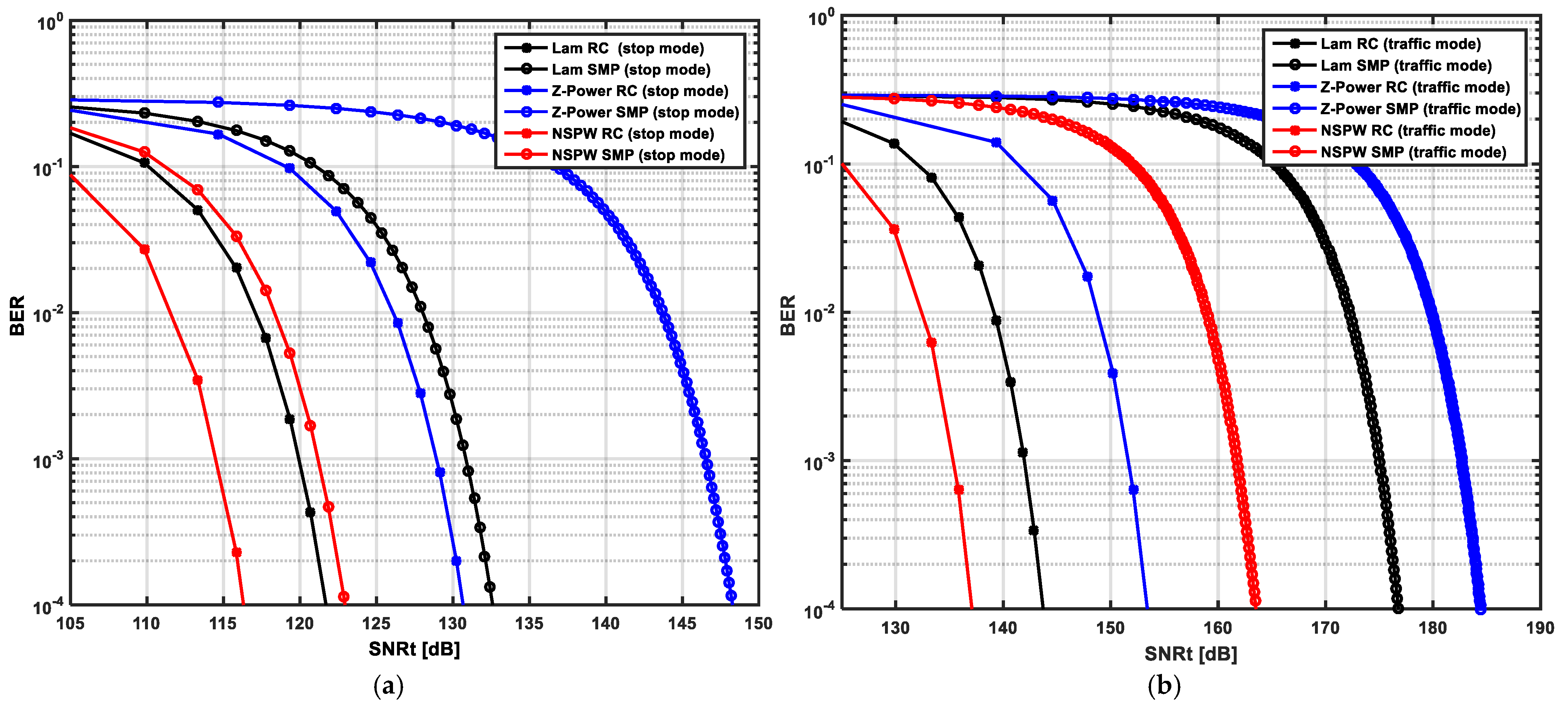

| Parameters | Values |
|---|---|
| Hight of transmitters | 0.8 m |
| Spacing of transmitters | 1.20 m |
| Number of transmitters | 2 |
| Emitted optical power of transmitters | 1 W (stop mode), 10 W (traffic mode) |
| LED Lambertian index | 1 |
| Receiver field of view | 90° |
| Hight of receiving plane | 0.8 m |
| Type of photodiode | PIN PD |
| Physical area of PD | 1.0 cm2 |
| Responsively of PD | 0.28 A/W |
| Concentrator refractive index | 1.54 |
| Optical filter gain | 1 |
| Spacing of receivers | 1.20 m |
| Number of transmitters | 2 |
| Channel | LOS |
| Meteorological visibility | 0.50 km |
| Modulation | M-PAM |
| Modulation bandwidth | 20 MHz |
Disclaimer/Publisher’s Note: The statements, opinions and data contained in all publications are solely those of the individual author(s) and contributor(s) and not of MDPI and/or the editor(s). MDPI and/or the editor(s) disclaim responsibility for any injury to people or property resulting from any ideas, methods, instructions or products referred to in the content. |
© 2024 by the authors. Licensee MDPI, Basel, Switzerland. This article is an open access article distributed under the terms and conditions of the Creative Commons Attribution (CC BY) license (https://creativecommons.org/licenses/by/4.0/).
Share and Cite
Ding, J.; I, C.-L.; Wang, J.; Yang, H. Link Characteristics Comparison of Lambertian & Non-Lambertian MIMO-Based 6G Vehicular Visible Light Communications. Inventions 2025, 10, 1. https://doi.org/10.3390/inventions10010001
Ding J, I C-L, Wang J, Yang H. Link Characteristics Comparison of Lambertian & Non-Lambertian MIMO-Based 6G Vehicular Visible Light Communications. Inventions. 2025; 10(1):1. https://doi.org/10.3390/inventions10010001
Chicago/Turabian StyleDing, Jupeng, Chih-Lin I, Jintao Wang, and Hui Yang. 2025. "Link Characteristics Comparison of Lambertian & Non-Lambertian MIMO-Based 6G Vehicular Visible Light Communications" Inventions 10, no. 1: 1. https://doi.org/10.3390/inventions10010001
APA StyleDing, J., I, C.-L., Wang, J., & Yang, H. (2025). Link Characteristics Comparison of Lambertian & Non-Lambertian MIMO-Based 6G Vehicular Visible Light Communications. Inventions, 10(1), 1. https://doi.org/10.3390/inventions10010001







